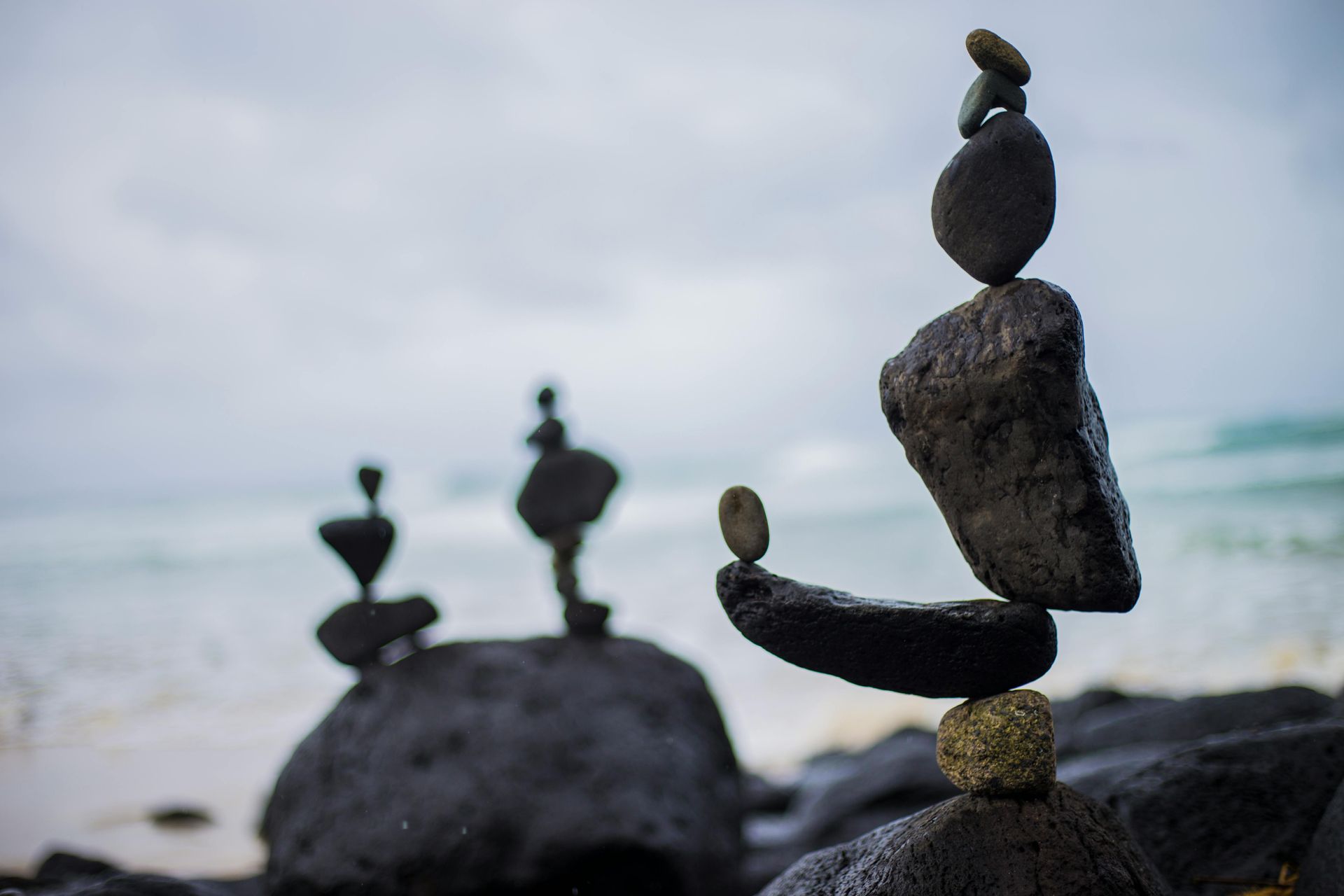Misery Stabilizers in a Relationship – What are yours?
Kathleen Maiman • March 19, 2019

What is a misery stabilizer? It is a behaviour or activity that helps us avoid, deny, distract or move away from pain within ourselves or in our relationships. Since pain or vulnerability is uncomfortable, we might choose a “misery stabilizer” because it is pleasurable. What is your favourite activity or pleasure that keeps you from facing a relational issue? Is it Netflix, Facebook, your phone, shopping, kids, friends, gambling, reading, sleeping, cleaning, exercise, food, hobbies, prescription drugs, alcohol, sexual compulsivity, or “busyness”?
Why are they harmful? They may stabilize your relationship; however, keep you from the opportunity of intimacy or deep engagement. If you want more passion and connection flowing in your relationship, you and your partner need to remove the crutches that hold in you in inertia.
John and Mary have had a long term relationship. Mary likes her job a lot. In fact, she could be at her desk 24/7 doing the real estate deals that she loves. She enjoys meeting the potential buyers, taking the folks to different homes, watching their faces light up as they describe their experiences going through the homes. With all that excitement and enthusiasm, she spends her time at the office and with the other real estate agents drawing up contracts and closing deals. She is filled with fulfillment and satisfaction of happy families moving in their new homes. This is her professional life and she loves it.
Mary has been spending more and more time focusing on her work life than at home. When she is at home, she is reminded of her poor sex life. Her husband John doesn’t touch her like he used to. In fact, he has been going through some depression. He was let go a year ago due to a downsizing of his company. Unfortunately, John is overqualified for the many positions that he has applied for and feels useless in the world and at home. Unable to offer much provision for his family, he spends a few pleasurable hours a day playing tennis. He has always loved tennis and is good at it. The sport gets his endorphins ignited, while experiencing the positive feelings of something he can excel at. When focused on tennis, he is not thinking about how much he feels like a failure within himself and around his wife.
John’s tennis partner is a woman. They have known each other for years. She was married to another fellow that used to play tennis with John. They are now going through a divorce. After her and John play their usual round, they meet for coffee and she shares the updates on her divorce proceedings, all the messiness, sorrow, and confusion. John can relate to her on some level at this time of his life. Because of the basic need for human connection, they form a bond. He tells her about his innermost world and she listens and empathizes. She commiserates on her challenges and he offers support. They are connected.
So, what are the misery stabilizers in this couple? Mary’s misery stabilizer is her work. She receives numerous accolades and fulfillment with her clients and work experiences. She is avoiding the pain and loneliness of not being in a fun, positive relationship with John. His sad, morose, complaining demeanor registers as a cue for danger in her nervous system. This brings up a feeling of discomfort within. She has little tolerance for anything negative in her outer or inner environment. In her early childhood, if she were sad, her parents immediately dismissed her feelings of sadness and said, “Oh it’s not that bad”. Any negative feelings were denied or suppressed. Trying to always be positive, they claimed that pain and suffering were a ‘waste of time’ and encouraged her to focus on her achievements. High achievers themselves, she learned from them to move away from negative feelings and focus on something pleasurable.
John had a parent who was depressed, his mother. She coped with life by drinking alcohol. John grew up in home of feeling neglected and ignored. As a child, he learned from his mother to look for something on the outside to mask and soothe the pain. Craving attention as a kid, he carries this unmet need and low self-esteem into his adulthood. John’s drug of choice is an outside relationship when dealing with uncomfortable feelings. With Mary spending more time at work, his feelings of neglect, loneliness, and unworthiness are triggered. His tennis partner gives him attention, and then he feels comfortable and okay. However, it doesn’t resolve his situation with Mary, as it is a diversion from her. Not revealing to Mary all of his intimate conversations that he is having with his tennis partner is a recipe for an “emotional affair” potentially leading to a sexual affair. Ultimately, this could cause more harm, hurt and betrayal in the future.
As we can see, misery stabilizers contribute to the creation of an “Invisible Divorce”. Even though the misery stabilizers make the situation a little more bearable and comfortable, they don’t offer a great connected relationship. Taking a stance to turn around, face a partner and deal with the misery in the relationship requires courage and commitment. Talking about the truth of ones’ innermost feelings with each other in a respectful, loving and constructive way is key!
If you are serious about changing a relationship, you will need to cut back altogether or stop anything that emotionally removes you from the reality of it. Putting away the diversions, turning around and facing your partner may not be easy, but you will be happy that you did.
Register for our Newsletter and receive a Free Love Chat Package
This Package Includes
- The 5 Steps to a Better Relationship
- Ongoing Monthly Relationship Tips
- If you want more love in your life, our relationship Love Chat Package is an easy cost-free first step.

When we first meet, we are the best version of ourselves. We take care of ourselves and show up as our best self. In the first few weeks and months of a relationship, we are on our A game. We dress up, plan dates, show up, have fun, we listen and we are in a good mood and say yes to new experiences and adventures. We a

When it comes to relationships—romantic, familial, or even friendships—there is an ongoing negotiation between what is true (facts) and what is felt (feelings). Both play vital roles in how partners connect, resolve conflicts, and build lasting trust. Understanding the balance between the two can mean the difference between constant misunderstandings and a relationship grounded in both honesty and empathy. Learning how to balance the two—without dismissing or overemphasizing either—can bring more peace, understanding, and intimacy.

As a relationship therapist, I am seeing more couples in my office with betrayals of deceit, infidelity and emotional affairs. My curiosity and compassion arises when working with these couples, helping them to move beyond the deceit and the betrayal. In the discovery process, we want to get to an understanding of how they got to this place of hurt and deceit. Here is one of a few blog posts on Betrayal and Infidelity. This one refers to “Why Partners Cheat”.

There are many myths floating around about marriage and relationships that can be detrimental and harmful to relationships. They can create unrealistic expectations and misunderstandings leaving couples down the wrong path, or worse, convince them that marriage is a hopeless cause. Good relationships can end early or fail because of these common myths. Let’s debunk them one by one.

Like many of us, I grew up in a family where there weren’t a lot of boundaries or assertiveness in requests. Rigid controlling behaviours were there instead of healthy boundaries. Here are some tips that I have learned about relationships and setting these boundaries. People have better relationships when there are healthy boundaries. And making requests, gives the other party the opportunity to meet us in our needs. Read on to better understand the difference between a request, a boundary, and an ultimatum.

In the spectrum of romantic relationships, there are four levels. The first stage is a crush . In this stage, you feel warm inside while hanging out with a man or a woman who pays attention to you, looks sweetly at you, smiles at you or who is kind to you. You find that you like each other. This is a crush and it passes away with time. It doesn`t stay strong and there is no significant bond there. Adapted from Sri Krishnaji – Co-founder of Oneness and World Centre for Enlightenment. Author of Four Sacred Secrets: For Love and Prosperity

A couple trudged into my therapy office, slumped down in their chairs and glared at one another. The tensions were high and the emotions were charged. This couple in their 40s had yet another fight on the way to their appointment. This fight was a continuation of something that started last night, but the truth was they had variations of the same argument for the last five years. “I’ve asked you to be kinder, but you speak to me with such contempt and attack me,” he complained. “But you’re doing things that upset me,” she counter-claimed. “What am I supposed to do?” They were at impasse and falling into this unhealthy dynamic over and over by making three common mistakes made by couples. What are these mistakes? Could knowing them transform your relationship?

With the holiday season upon us, aliveness and energy is in the air. The season can also be fraught with frenzy and heightened emotions. It is not uncommon for couples to be overwhelmed or disconnected during the holidays, especially if one or both of the partners gets triggered by certain events. The added stress can create relationship strife and difficulties.










